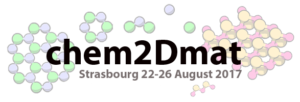Materials Horizons will be supporting the 1st European Conference on Chemistry of Two-Dimensional Materials (Chem2DMat), which will take place in Strasbourg on 22-26 August 2017. This conference aims at providing a forum to the rapidly growing community of scientists mastering the chemical approaches to 2D materials in order to fabricate systems and devices exhibiting tunable performance.
The conference will cover all areas related to 2D materials’ chemistry spanning their synthesis as well as their functionalization, using covalent and non-covalent approaches, for composites, foams and coatings, membranes, (bio-)sensing, (electro- and photo-)catalysis, energy conversion, harvesting and storage, electronics, nanomedicine, biomaterials, with sessions on the following themes:
- Synthesis, processing and multiscale characterization
- Bottom-up growth
- Covalent and non-covalent functionalization
- Synthetic two-dimensional materials
- Design of 3D functional materials from layered systems
Some important deadlines:
- Abstract submission (poster & talks) on 15 June
- Early-bird registration ends 15 May
Visit the website for a full list of the speakers and to register your interest: http://bit.ly/chem2Dmat_reg











